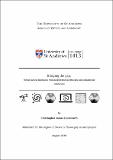Files in this item
Bridging the gap : stellar and gas kinematics from integral field spectroscopy and cosmological simulations
Item metadata
| dc.contributor.advisor | Tojeiro, Rita | |
| dc.contributor.author | Duckworth, Christopher | |
| dc.coverage.spatial | 213 p. | en_US |
| dc.date.accessioned | 2021-04-22T11:45:45Z | |
| dc.date.available | 2021-04-22T11:45:45Z | |
| dc.date.issued | 2021-06-21 | |
| dc.identifier.uri | https://hdl.handle.net/10023/23078 | |
| dc.description.abstract | We are now in an era of spatially resolved spectroscopic observations for thousands of galaxies. Labelled integral field spectroscopy, a natural product is detailed kinematics of both stars and gas enabling accurate estimators of a galaxy's angular momentum, and hence, kinematic classifications. This presents a significant step forward in how we understand and classify galaxies, previously being reliant on their visual form; morphology. In tandem, significant progress has also been made in theory with realistic, cosmological simulations becoming a reality. These high resolution simulations, coupled with hydrodynamics, have produced populations of thousands of galaxies; replicating a wide variety of properties of actual galaxies in our observable Universe. Both will be crucial in further understanding how galaxies evolve to what we find in the local Universe. This thesis uses the natural synergy between integral field spectroscopy and cosmological hydrodynamical simulations, to help understand the angular momentum content of galaxies in the local Universe. We investigate the relationship between thousands of galaxies' stellar and gas kinematics using both real and mock observations, to better understand the reliability of such simulations, and, how they can intuit their evolutionary histories. In this thesis, we investigate how the rotational direction of stars and gas can become decoupled (kinematic misalignment) and how this is related to the galaxy's morphology and the angular momentum content of the surrounding dark matter halo (Chapter 2). We also demonstrate the relationship between kinematic misalignment and stellar angular momentum, and how both are impacted by the role of feedback from supermassive black holes (Chapter 3), and, their large-scale environment. In particular, we investigate how the magnitude and direction of angular momentum in galaxies is modulated by their position within the cosmic web (Chapter 4), and, how kinematic misalignment is related to the assembly history of their dark matter halo (Chapter 5). Finally this thesis investigates the potential to recover the dynamics of dark matter within different large-scale environments (Chapter 6), motivating a novel application of the axisymmetric Jean's equations using whole galaxies as tracers. This work helps lay the foundation for using integral field spectroscopy and cosmological simulations, in tandem, as a powerful tool in building a holistic picture of galaxy evolution. | en_US |
| dc.language.iso | en | en_US |
| dc.publisher | University of St Andrews | |
| dc.relation | Decoupling the rotation of stars and gas - I. The relationship with morphology and halo spin (https://arxiv.org/abs/1910.10744) | en_US |
| dc.relation | Decoupling the rotation of stars and gas - II. The link between black hole activity and simulated IFU kinematics in IllustrisTNG (https://arxiv.org/abs/1911.05091) | en_US |
| dc.relation | SDSS-IV MaNGA: signatures of halo assembly in kinematically misaligned galaxies (https://arxiv.org/abs/1811.06408) | en_US |
| dc.rights | Creative Commons Attribution 4.0 International | * |
| dc.rights.uri | http://creativecommons.org/licenses/by/4.0/ | * |
| dc.subject | Galaxy evolution | en_US |
| dc.subject | Cosmic web | en_US |
| dc.subject | Dark matter | en_US |
| dc.subject | Galaxy angular momentum | en_US |
| dc.subject | Hydrodynamical simulations | en_US |
| dc.subject | Integral field spectroscopy | en_US |
| dc.title | Bridging the gap : stellar and gas kinematics from integral field spectroscopy and cosmological simulations | en_US |
| dc.type | Thesis | en_US |
| dc.contributor.sponsor | Science and Technology Facilities Council (STFC) | en_US |
| dc.type.qualificationlevel | Doctoral | en_US |
| dc.type.qualificationname | PhD Doctor of Philosophy | en_US |
| dc.publisher.institution | The University of St Andrews | en_US |
| dc.publisher.department | Center for Computational Astrophysics, Flatiron Institute (Simons Foundation) | en_US |
| dc.identifier.doi | https://doi.org/10.17630/sta/61 | |
| dc.identifier.grantnumber | ST/N504427/1 | en_US |
The following licence files are associated with this item:
This item appears in the following Collection(s)
Except where otherwise noted within the work, this item's licence for re-use is described as Creative Commons Attribution 4.0 International
Items in the St Andrews Research Repository are protected by copyright, with all rights reserved, unless otherwise indicated.


